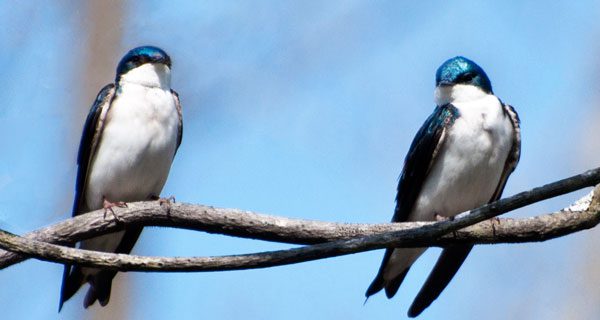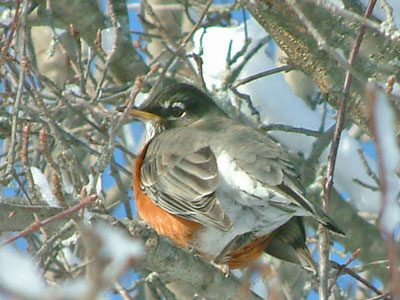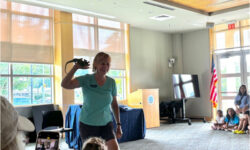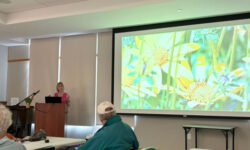[ccfic caption-text format="plaintext"]
By Lisa Moore
Hometown Weekly Correspondent
Winter is coming, and with it comes a host of changes. Shorter daylight hours lead to long winter nights, temperatures drop, snow blankets the region, and once lush and vibrant green spaces turn brown and wither.
How does the local wildlife survives such harsh conditions?
Curious residents filled the Wakelin Room at the Wellesley Free Library to learn about “Wellesley Wildlife in Winter.” Co-hosted by Wellesley Conservation Council and Wellesley Free Library, the evening talk, presented by Joy Marzolf, Community Outreach Coordinator for Mass Audubon’s Broadmoor Wildlife Sanctuary, spoke about how local wildlife survives winter by hibernating, migrating, or pinning their survival hopes on overwintering eggs and larvae.
Each different animal has adapted different methods of winter survival, impacting what animals we see in the area during winter.
For the tree swallow and other insectivores, winter brings a loss of available food. Like some other insectivores, Tree swallows will fly south as winter comes, following their food source out of Massachusetts and seeking warmer climates where insects still thrive. Other birds in the area, like the robin, which eats worms, stay put in the winter, surviving on fruits and berries. For other birds like the dark-eyed junco, Massachusetts is south; they come to the region in autumn from further north, looking for insects and seeds.
For some animals, winter means hibernation. How an animal hibernates varies from species to species. Woolly bear caterpillars, tree frogs, and spring peepers have interesting hibernation methods. Adapted to create special cryoprotectant’s that prevent cell death, these animals freeze solid over the winter months, temporarily halting bodily functions and waiting for temperatures to warm. In the spring when the animals thaw, they resume metabolic functions and become active again. For insects like the dragonfly, larval stages that develop in water will overwinter in the mud and muck at the bottom of a water body; they will later go through metamorphosis in spring, emerging as adult dragonflies.
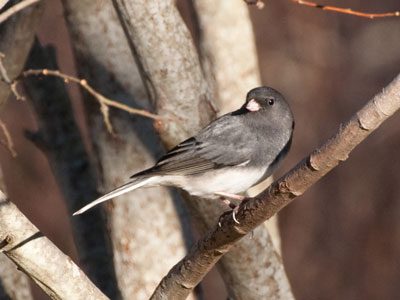
A dark-eyed junco. For the junco, the local area is south; the birds migrate here from their northern summer stomping grounds.
One interesting fact Marzolf shared was about the importance of keystone or cornerstone species. These species play a critical role in maintaining the healthy structure of an ecological community. Their presence effects many organisms in an ecosystem and effect types and numbers of many other animals in the community. The keystone species plays a role in the function of the ecosystem; without the keystone species, the ecosystem will be dramatically changed or fail to exist completely.
Marzolf spoke about the chipmunk as a local keystone species. Chipmunks notoriously dig holes and tunnels as a part of their survival. Many other animals that are incapable of digging use the chipmunk holes for their own survival - for instance, insects and snakes will often overwinter in abandoned chipmunk tunnels, tunnels they could not dig on their own. Without the chipmunks, many animals in the local ecosystem would not be able to survive.
While for many animals, winter is a time of slowing down, hiding out, and working on surviving, it is an active time for others. The great horned owl, for example, nests and breeds in winter. As the season draws near, the quiet of night can be broken by the duet of hooting calls from mating pairs. With extended hours of darkness, this nocturnal predator thrives.
Marzolf shared another fun way to catch a glimpse of the critters that visit your yard in winter by observing tracks left in snow. Often, people may not observe animals out during the day, but tracks in snow show evidence of busy activity. Birds, rabbits, skunk, deer, coyote, and raccoon are some animals that might leave tracks through one’s yard in winter.
One thing people can do to ensure all animals have what they need to survive each season is to be good stewards of the environment. An example revolves around the milkweed plant. For many, the milkweed plant is a hated weed, pulled out of gardens as a scourge. Doing so leaves monarch butterflies, whose caterpillars feed on milkweed, without their needed food source when they arrive from their migration. Simple solutions like controlling invasive species, encouraging growth of native plants, planting animal attractors, and limiting habitat destruction are a few ways to aid wildlife in their quest for survival.
For those looking for fun ways to get out and explore nature and the wildlife that inhabits the area, Broadmoor Wildlife Sanctuary in Natick offers many opportunities - like evening owl prowls, animal tracking outings, and the upcoming State of the Birds Address presented by Joan Walsh on Thursday, December 14, at 7:30 p.m. Ms. Walsh will discuss the state of local birds, and how they are surviving in Massachusetts. This event is a great appetizer before the Christmas bird count.
For more information on this and other programs, visit www.massaudubon.org/broadmoor.




